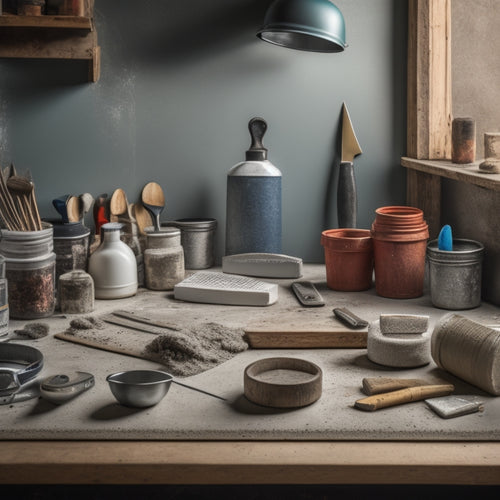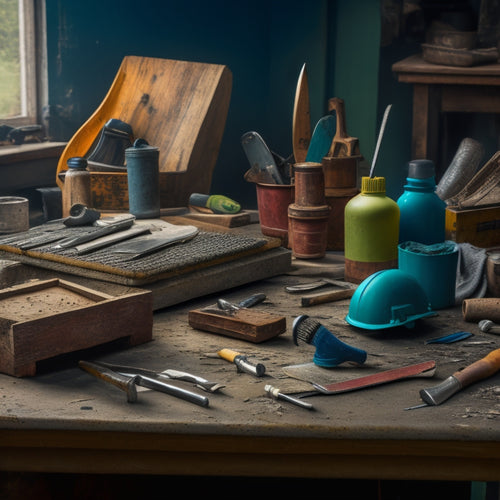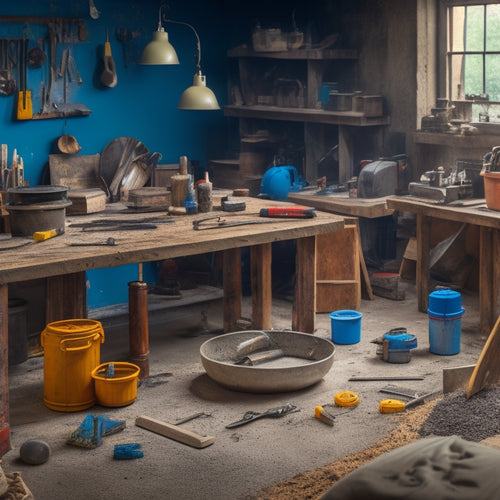
5 Must-Have Tools for Polished Concrete Floors
Share
You'll need a strategic arsenal of specialized tools to transform raw concrete into a polished, high-gloss masterpiece. Five must-haves include a reliable grinder for smoothing out imperfections, a polisher to achieve that high-gloss finish, an edger for precise control in tight spaces, diamond tools for aggressive cutting, and safety equipment to protect yourself from the polishing process. With these essentials, you'll be well-equipped to tackle any polished concrete floor project. By understanding the unique role each tool plays, you'll reveal the full potential of your polished concrete floors, and that's just the starting point for achieving flawless, show-stopping results.
Key Takeaways
• Essential grinders, including walk-behind, ride-on, and handheld models, remove imperfections and prepare surfaces for polishing.
• Polishers, such as planetary and rotary models, achieve high-gloss finishes through a multi-step process of coarse to fine grits.
• Edgers with compact designs and variable speed control ensure precise control and high-quality edge finishing in tight spaces.
• Diamond tools, including blades with high and low concentration, efficiently cut through concrete and refine surfaces with consistent pattern and pressure.
• Safety equipment, including safety goggles, dust masks, steel-toed boots, and gloves, protect operators from debris, dust, and heavy equipment.
Essential Grinders for Smoothing
Your polished concrete floor project requires a reliable grinder that can efficiently remove imperfections and prepare the surface for further refinement.
When it comes to grinder types, you'll need to choose between walk-behind, ride-on, and handheld models. Walk-behind grinders are ideal for large areas, while ride-on grinders offer increased productivity and reduced operator fatigue. Handheld grinders, on the other hand, are perfect for tight spaces and detail work.
Regardless of the type, regular maintenance is essential to extend the life of your grinder. Make it a habit to check and replace worn-out parts, such as diamond tools and abrasives, to guarantee peak performance.
Additionally, keep your grinder clean and well-lubricated to prevent overheating and motor damage. By following these maintenance tips, you'll be able to achieve a smooth, even surface that's ready for the next stage of polishing.
With the right grinder and proper maintenance, you'll be well on your way to creating a stunning polished concrete floor that showcases your attention to detail and commitment to quality.
Polishers for High-Gloss Finish
With your concrete floor now smooth and even, you're ready to bring out the high-gloss finish using polishers specifically designed for this stage of the process. At this point, you'll need to switch to a different type of polisher, one that's capable of producing a high-shine finish.
There are two primary polisher types to evaluate: planetary polishers and rotary polishers. Planetary polishers are ideal for achieving a high-gloss finish, as they use multiple rotating heads to apply even pressure and distribute polishing compounds uniformly. Rotary polishers, on the other hand, are better suited for larger areas and can be used for both polishing and grinding.
When it comes to finish techniques, you'll want to employ a multi-step process, starting with a coarse grit and gradually moving to finer grits. This will help you achieve a flawless, reflective finish. Be sure to work in small sections, applying the polishing compound in a consistent, even pattern.
Edgers for Tight Spaces
When working on polished concrete floors, you'll inevitably encounter tight spaces, such as corners, edges, and stairwells, where standard polishers can't reach, making edgers an essential tool for achieving a seamless finish.
Edgers are specifically designed to tackle these hard-to-reach areas, ensuring a consistent, high-quality edge finishing. Their compact designs allow for precise control and maneuverability, making them perfect for traversing tight spaces.
When selecting an edger, look for one that offers variable speed control, allowing you to adjust the speed to suit the specific task at hand. This feature is particularly useful when working with delicate or intricate edges.
Additionally, consider an edger with interchangeable diamond tooling, which enables you to switch between different grits and tooling configurations as needed. This versatility is vital for achieving a flawless finish.
Diamond Tools for Aggressive Cutting
Aggressive cutting demands diamond tools that can withstand the intense forces and heat generated during the polishing process, making them an essential component of your arsenal for achieving a high-gloss finish. You need diamond blades that can efficiently cut through concrete, remove imperfections, and refine the surface.
When selecting diamond tools, consider the following:
-
Diamond blade types: Choose blades with a high concentration of diamonds for aggressive cutting, and those with a lower concentration for finer polishing.
-
Cutting technique tips: Maintain a consistent cutting pattern, apply moderate pressure, and keep the blade cool to prevent overheating.
-
Blade maintenance: Regularly inspect and clean your blades to guarantee peak performance and extend their lifespan.
Safety Equipment for Protection
You'll need to prioritize your safety by wearing personal protective equipment (PPE) to shield yourself from the hazards associated with operating diamond tools. Failing to do so can result in serious injuries, respiratory problems, or even long-term health issues.
When working with polished concrete floors, it's crucial to protect your eyes, skin, and respiratory system from the dust and debris generated during the process. Here are some must-have safety equipment to keep in mind:
| Safety Equipment | Purpose |
|---|---|
| Safety Goggles | Protect eyes from flying debris and dust |
| Dust Masks | Filter out airborne particles and prevent respiratory issues |
| Steel-Toed Boots | Prevent foot injuries from heavy tools and equipment |
| Gloves | Provide grip and protection for hands from cuts and abrasions |
Frequently Asked Questions
What Is the Ideal Concrete Hardness for Polishing?
When you're preparing for polishing, you'll want to verify the ideal concrete hardness, typically between 25-35 MPA, which you can determine through concrete hardness testing, and adjust your polishing techniques accordingly for best results.
Can I Polish New or Freshly Poured Concrete?
You've wondered if you can polish fresh concrete, and research suggests it's possible, but not recommended, as it may compromise the slab's integrity; instead, wait 28 days for full hydration, revealing the benefits of polishing, such as enhanced durability and aesthetic appeal.
How Often Should I Maintain Polished Concrete Floors?
You'll want to establish a frequency schedule for maintaining your polished concrete floors, using high-quality maintenance products to guarantee a consistent shine; aim for daily sweeping, weekly cleaning, and monthly deep cleaning to preserve their luster.
Are Polished Concrete Floors Slippery When Wet?
As you step onto polished concrete floors, wet and glistening like a mirror, you wonder if they'll send you slipping and sliding. Rest assured, with proper finishing, polished concrete safety is enhanced, boasting high slip resistance, giving you a secure grip even when wet.
Can I Polish Concrete Floors With Existing Coatings?
You'll need to remove existing coatings before polishing, as they'll interfere with the process. You'll have to undertake thorough coating removal and surface preparation to guarantee a strong bond between the concrete and new finish.
Conclusion
As you stand back to admire your handiwork, the polished concrete floor shines like a mirror, reflecting your expertise.
Just as a master painter selects the finest brushes, you've chosen the right tools for the job. Your arsenal of grinders, polishers, edgers, diamond tools, and safety gear has transformed a rough slab into a work of art.
With these must-haves, you've released the beauty within, and the results are nothing short of breathtaking. Your polished concrete floor is a masterpiece, a demonstration of your skill and dedication.
Related Posts
-

Essential Tools for Concrete Wall Covering Projects
When tackling a concrete wall covering project, you'll need a range of essential tools and equipment. For cleaning an...
-

Must-Have Handheld Tools for Concrete Repair
When tackling a concrete repair project, it is crucial to have the right handheld tools to achieve a professional fin...
-

Budget-Friendly Tools for DIY Decorative Concrete Profiling
You can achieve professional-grade decorative concrete results on a budget by investing in the right combination of e...


